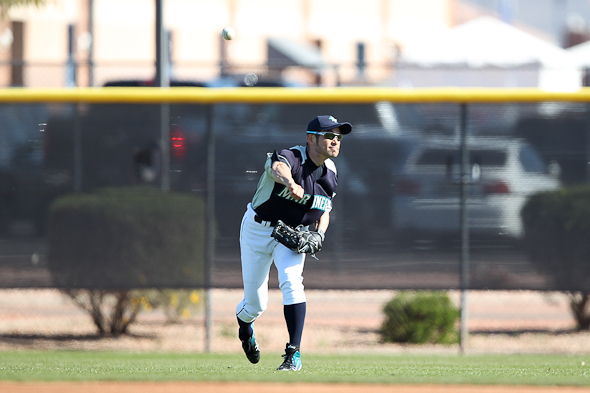caption id=”attachment_2113265″ align=”aligncenter” width=”590″ caption=”Ichiro kept his spot in the field, but not in the batting order. / Drew McKenzie, Sportspress Northwest”] [/caption]
[/caption]
Its long been assumed that one of the reasons Ichiro preferred to lead off, to the exclusion of any other spot in the Mariners batting order, is that batting first is the easiest way to get to 200 hits.
Its all about math and plate appearances. The leadoff hitter gets more chances to come to the plate. The more chances a good hitter gets, the more hits hes likely to have.
Ichiro never overtly said that his comfort zone as a leadoff hitter has a direct link to his annual pursuit of 200 hits. The case can be made that his collection of singles, doubles and infield dribblers is a natural fit at the top of the order.
But now we know that hes going to be out of his comfort zone. Manager Eric Wedge said this week he is moving the 10-time All-Star to third in the order. The question:
If Ichiro still wants to be a 200-hits-per-year guy (he had 184 in 2011), will the move to third in the lineup cost him his chance?
Probably not. The statistical impact of the move is not as much as he, or anyone, might think. In his 161 games last year, Ichiro got to the plate 23 more times than the random collection of No. 3 hitters the Mariners went through. How did that play out?
In his 10 consecutive seasons of 200-plus hits before he fell to a .272 average last year, the closest call he had in missing 200 came in 2005, at 206. If his 2011 average of 5.87 hits per 23 plate appearances held true back in 2005, missing 23 plate trips would have left him with exactly 200 hits.
So theoretically at least, in none of his 10 200-hit seasons would he have lost out on getting to 200 hits by losing as many as 23 plate appearances.
It should be noted that the difference of 23 plate appearances between the first guy and the third guy for the Mariners was on the small side. In the major leagues last year, leadoff hitters had, on average, 35 more plate appearances than No. 3 hitters, 755 to 720, respectively.
The point is noteworthy because if the Mariner offense revs up, the difference between batting first and third for Seattle could well be more than 23 plate appearances.
Even then, thats not necessarily a 200-hit deal-breaker.
If Wedges hunch is correct and these moves make new leadoff man Chone Figgins and Ichiro both more productive, then the Seattle offense, which had the fewest hits, plate appearances, at-bats and lowest batting average in the American League last year, figures to be more productive as a whole. Everybody in the lineup would get to the plate more.
All of this assumes that Ichiros 2011 season was a fluke and hell be back with hits raining off his bat at his pre-2011 clip. Wedge, talking to the Seattle media Wednesday, seemed to say he liked the 38-year-old Ichiros chances of returning to form.
“Hes got a little bit of a different approach, Wedge said. “Hes doing some things that he feels he needs to do. I have a tremendous amount of respect for that. This guy doesnt just do anything on a whim. There is always thought process behind it.
“Hes a smart baseball player. Hes a great worker. His discipline, his routine and his workout stick out. Its one of the reasons hes a great player and a great hitter. I really appreciate what Im seeing right now.
